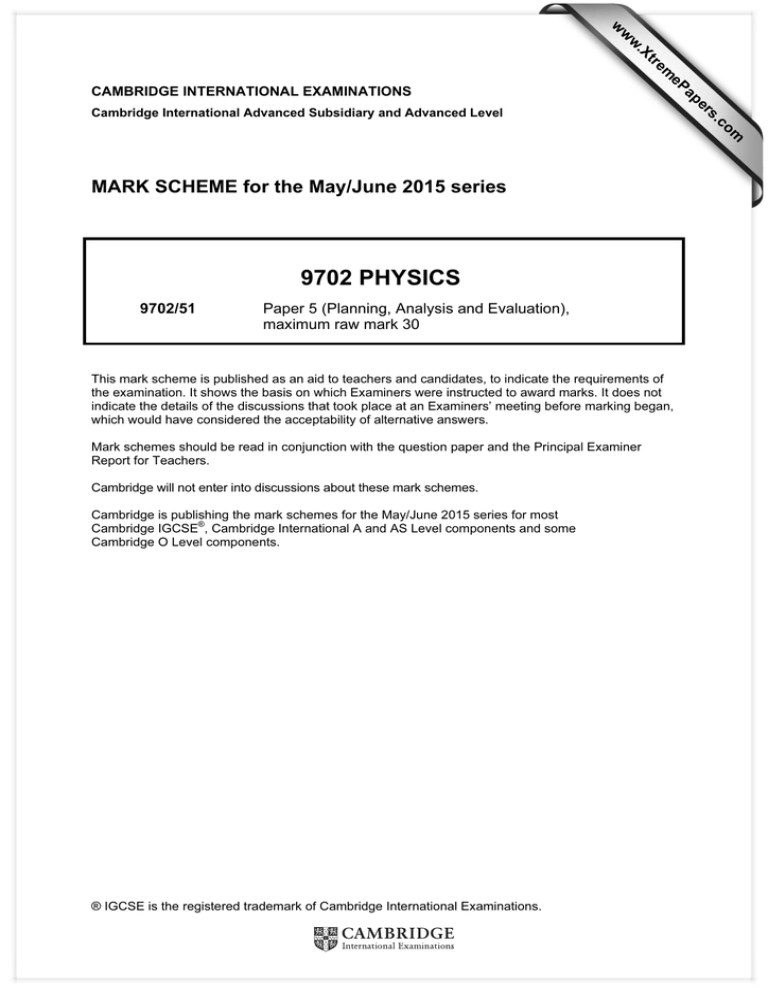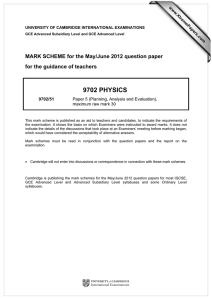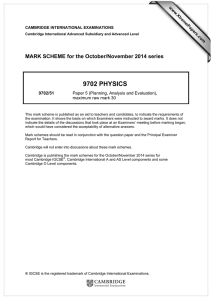9702 PHYSICS MARK SCHEME for the May/June 2015 series
advertisement

w w ap eP m e tr .X w CAMBRIDGE INTERNATIONAL EXAMINATIONS om .c s er Cambridge International Advanced Subsidiary and Advanced Level MARK SCHEME for the May/June 2015 series 9702 PHYSICS 9702/51 Paper 5 (Planning, Analysis and Evaluation), maximum raw mark 30 This mark scheme is published as an aid to teachers and candidates, to indicate the requirements of the examination. It shows the basis on which Examiners were instructed to award marks. It does not indicate the details of the discussions that took place at an Examiners’ meeting before marking began, which would have considered the acceptability of alternative answers. Mark schemes should be read in conjunction with the question paper and the Principal Examiner Report for Teachers. Cambridge will not enter into discussions about these mark schemes. Cambridge is publishing the mark schemes for the May/June 2015 series for most Cambridge IGCSE®, Cambridge International A and AS Level components and some Cambridge O Level components. ® IGCSE is the registered trademark of Cambridge International Examinations. Page 2 1 Mark Scheme Cambridge International AS / A Level – May / June 2015 Syllabus 9702 Paper 51 Planning (15 marks) Defining the problem (3 marks) V is the independent variable, or vary V and f is the dependent variable, or measure f. Or f is the independent variable, or vary f and V is the dependent variable, or measure V. [1] P Change f (allow V) until the mass leaves/gap between plate. [1] P Keep the position of the mass constant. (Do not allow keep mass constant.) [1] P Methods of data collection (5 marks) M Labelled diagram showing signal generator/a.c. supply connected to vibrator with two wires with mass on plate. At least two labels needed. [1] M Voltmeter/c.r.o. connected in parallel with vibrator in a workable circuit. [1] M Measure f or T from signal generator/c.r.o. (Allow detailed use of motion sensor/stroboscope.) [1] M Detail regarding mass leaving the plate: listen to noise, look for gap. [1] M Repeat each experiment for the same value of V (allow f if consistent with above) and average. [1] Method of analysis (2 marks) Plot a graph of: A A f2 against 1/V 1/V against f2 f against or or or or V against 1/f2 1/f2 against V V against 1/f 1/f against k= gradient × π2 k= 1/ V k= π2 2 2 gradient gradient × π lg V against lg f 1/ V against f lg f against lg V [1] V k= π2 gradient2 k = π 2 × 10 c k = π 2 × 10 2c [1] Safety considerations (1 mark) S Precaution linked to mass leaving vibrating plate, e.g. use safety screen/goggles/sand tray. © Cambridge International Examinations 2015 [1] Page 3 Mark Scheme Cambridge International AS / A Level – May / June 2015 Syllabus 9702 Paper 51 Additional detail (4 marks) D 1 2 3 4 5 6 7 8 Relevant points might include Wait for vibrator to oscillate evenly Method to determine period of oscillation from c.r.o., i.e. one time period × time-base Method to determine f from c.r.o. having determined T, i.e. f = 1 / T Method to determine V from c.r.o, i.e. amplitude (height) × y-gain Relationship is valid if the graph is a straight line passing through the origin [For lg – lg graph the gradient must be correct (–2 or –0.5)] Determine f (allow V if consistent with above) by increasing and decreasing V or f Clean surfaces of metal plate/small mass Spirit level to keep plate horizontal/eye level to look for gap Do not allow vague computer methods. © Cambridge International Examinations 2015 [4] Page 4 2 Mark Scheme Cambridge International AS / A Level – May / June 2015 Syllabus 9702 Paper 51 Analysis, conclusions and evaluation (15 marks) Mark Expected Answer (a) A1 gradient = m y-intercept = lg k (b) T1 T2 (c) (i) (ii) (iii) (iv) Additional Guidance 1.70 or 1.699 1.312 or 1.3118 1.79 or 1.785 1.204 or 1.2041 1.85 or 1.851 1.114 or 1.1139 1.90 or 1.903 1.041 or 1.0414 1.95 or 1.954 0.98 or 0.978 2.00 or 1.996 0.90 or 0.903 Allow a mixture of significant figures. T1 (first column) and T2 (second column) must be values in table. U1 From ±0.01 to ±0.03 Allow more than one significant figure. G1 Six points plotted correctly Must be within half a small square. Do not allow “blobs”. Ecf allowed from table. U2 Error bars in lg P plotted correctly All error bars to be plotted. Must be accurate to less than half a small square. G2 Line of best fit Upper end of line must pass between (1.75, 1.24) and (1.75, 1.255) and lower end of line must pass between (2.00, 0.900) and (2.00, 0.915). G3 Worst acceptable straight line. Steepest or shallowest possible line that passes through all the error bars. Line should be clearly labelled or dashed. Examiner judgement on worst acceptable line. Lines must cross. Mark scored only if error bars are plotted. C1 Gradient of line of best fit Must be negative. The triangle used should be at least half the length of the drawn line. Check the read-offs. Work to half a small square. Do not penalise POT. (Should be about –1.35.) U3 Uncertainty in gradient Method of determining absolute uncertainty: difference in worst gradient and gradient. C2 y-intercept Check substitution into y = mx + c. Allow ecf from (c)(iii). (Should be about 4.) Do not allow read-off of false origin. © Cambridge International Examinations 2015 Page 5 (d) (i) (ii) Mark Scheme Cambridge International AS / A Level – May / June 2015 Syllabus 9702 U4 Uncertainty in y-intercept C3 k = 10y-intercept C4 m = gradient and given to 2 or 3 s.f. Must be negative. Allow –1.3 or –1.4 (2 s.f.) and in the range –1.30 to –1.44 U5 Percentage uncertainty in k Paper 51 Uses worst gradient and point on worst acceptable line. Do not check calculation. Do not allow if false origin used. Uncertainties in Question 2 (c) (iii) Gradient [U3] uncertainty = gradient of line of best fit – gradient of worst acceptable line uncertainty = ½ (steepest worst line gradient – shallowest worst line gradient) (iv) [U4] uncertainty = y-intercept of line of best fit – y-intercept of worst acceptable line uncertainty = ½ (steepest worst line y-intercept – shallowest worst line y-intercept) (d) (ii) [U5] max k = 10max y-intercept and min k = 10min y-intercept 1 (max k − min k ) k − min k max k − k × 100 = 2 × 100 = percentage uncertainty = × 100 k k k © Cambridge International Examinations 2015

